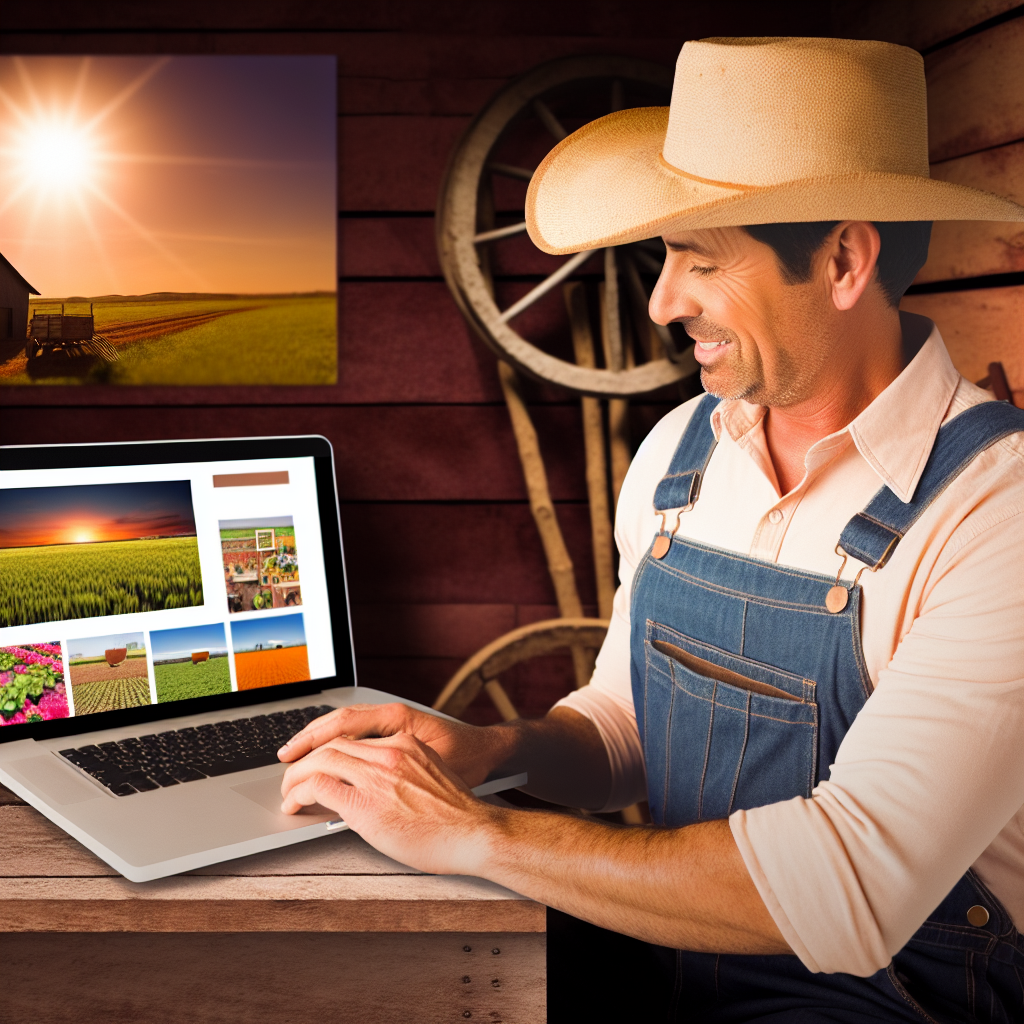Understanding the Importance of an Online Presence for Farmers
Access to New Markets
An online presence allows farmers to reach new customers effectively.
By utilizing e-commerce platforms, they can sell directly to consumers.
This strategy expands their market reach beyond local areas.
Therefore, farmers can increase their sales and profits significantly.
Building Brand Awareness
A strong online presence enhances brand visibility among consumers.
Farmers can showcase their products through engaging content and visuals.
This approach builds trust and fosters loyalty among customers.
Moreover, social media platforms are ideal for sharing farm stories.
Staying Competitive
The agriculture industry is evolving with technology and consumer preferences.
Farmers must adapt to these changes to remain relevant.
By establishing an online presence, they can stay competitive in the market.
Furthermore, they can gather customer feedback and adjust their strategies accordingly.
Accessing Valuable Resources
Online platforms offer farmers access to educational resources.
They can find up-to-date information on agricultural practices and trends.
This knowledge empowers them to improve their farming techniques.
Transform Your Agribusiness
Unlock your farm's potential with expert advice tailored to your needs. Get actionable steps that drive real results.
Get StartedAdditionally, they can connect with industry experts and peers for advice.
Enhancing Customer Interaction
Online presence enables direct communication with customers.
Farmers can respond to inquiries and provide information quickly.
This interaction helps build strong relationships with their customer base.
As a result, they can create a community around their brand.
Networking Opportunities
Establishing an online presence opens doors for networking.
Farmers can collaborate with other professionals in the industry.
This collaboration can lead to shared resources and innovative practices.
Furthermore, they can participate in online forums for knowledge exchange.
Identifying Your Target Audience
Identifying your target audience is crucial for online success.
Start by considering who benefits from your products or services.
Your audience may include local consumers, restaurants, and retailers.
Next, think about demographic factors such as age and location.
Different groups may have unique preferences and needs.
Understanding Consumer Needs
Understanding what drives your consumers is essential.
Many customers seek quality, sustainability, and freshness in food.
Others may be interested in specific types of produce.
Knowing these factors helps tailor your marketing strategy.
Researching Your Market
Conduct thorough market research to gather insights.
Utilize surveys or social media polls to engage potential customers.
Analyze competitors to see whom they target and how.
This research informs your messaging and outreach efforts.
Developing Customer Personas
Creating customer personas can simplify engagement.
Identify common characteristics that define your ideal customers.
Showcase Your Farming Business
Publish your professional farming services profile on our blog for a one-time fee of $200 and reach a dedicated audience of farmers and agribusiness owners.
Publish Your ProfileInclude details like lifestyle, preferences, and buying patterns.
Your persona will guide your communication style and marketing efforts.
Benefits of Customer Personas
Customer personas help focus your marketing initiatives.
They allow for personalized content and direct communication.
This increases the chances of building lasting relationships.
Engaging with Your Audience
Engagement is key to establishing a strong online presence.
Utilize social media platforms to share updates and stories.
Encourage feedback to improve your offerings continually.
A responsive approach fosters community and loyalty.
Evaluating Your Target Audience
Regularly assess your audience to adapt to changes.
Consumer preferences can shift based on trends and seasons.
Stay informed about developments in the agricultural sector.
This awareness allows you to pivot your strategy when needed.
Creating a User-Friendly Website
Focus on Design
A clean and simple design improves user experience.
Choose colors that reflect your farm’s identity.
Ensure fonts are easily readable across devices.
Include high-quality images that showcase your farm.
Maintain consistent branding to enhance recognition.
Optimize Content for Users
Provide clear and concise information about your products.
Use headings and bullet points for easy navigation.
Include customer testimonials to build trust.
Regularly update content to keep visitors engaged.
Implement a blog to share insights and tips.
Enhance Site Navigation
Organize the site with intuitive menus and links.
Implement a search feature to assist users in finding information.
Add a contact page with multiple communication options.
Make sure all links are functional and point to relevant content.
Consider a sitemap for easy access to main sections.
Mobile Responsiveness
Ensure your website is mobile-friendly for all users.
Test the site on various devices to guarantee functionality.
Optimize loading times to reduce bounce rates.
Design buttons that are easy to tap on smaller screens.
Adjust images and text for different display sizes.
SEO Best Practices
Utilize relevant keywords in your content for better visibility.
Write meta descriptions that accurately describe page content.
Incorporate alt text for images to improve accessibility.
Link to reputable sources to increase your site’s authority.
Encourage social sharing to enhance online presence.
You Might Also Like: Building Customer Loyalty in Agribusiness
Leveraging Social Media Platforms for Farm Promotion
Choosing the Right Platforms
Selecting the appropriate social media platforms is crucial for farmers.
Showcase Your Farming Business
Publish your professional farming services profile on our blog for a one-time fee of $200 and reach a dedicated audience of farmers and agribusiness owners.
Publish Your ProfileDifferent platforms serve unique audiences and formats.
For example, Instagram emphasizes visual content and storytelling.
Conversely, Twitter is ideal for quick updates and engagement.
Evaluating your target audience helps determine the best platform.
Creating Engaging Content
Engaging content is vital for capturing audience attention.
Share high-quality images and videos of farm activities.
Behind-the-scenes content humanizes your farming operations.
Include educational posts about agricultural practices.
Interactive posts can generate more engagement and feedback.
Building a Community
Social media facilitates community building among farmers and consumers.
Encourage followers to share their experiences and stories.
Respond to comments and messages promptly.
Moreover, creating specific hashtags fosters conversations.
This practice enhances the sense of belonging within your community.
Utilizing Analytics for Improvement
Analyzing your social media performance can drive improvement.
Use platform analytics to understand your audience better.
Identify which types of content yield the most engagement.
Adjust your strategy based on these insights for future posts.
This iterative approach leads to more effective outreach.
Uncover the Details: Building Long-Term Strategic Partnerships In Farming
Utilizing SEO Techniques to Increase Your Online Visibility
Understanding SEO Basics
Search Engine Optimization (SEO) is crucial for increasing your online presence.
It involves optimizing your website to rank higher in search results.
Every farmer can benefit from implementing effective SEO strategies.
Keyword Research
Start by identifying relevant keywords for your agriculture niche.
Use tools like Google Keyword Planner and SEMrush to find high-ranking terms.
Focus on long-tail keywords that reflect user intent and local relevance.
Incorporating these keywords naturally enhances your content’s visibility.
Content Creation
Create informative and engaging content for your audience.
Consider writing blog posts about farming techniques or seasonal tips.
Additionally, share success stories and personal experiences in farming.
Visual elements like images and videos make your content more appealing.
On-Page Optimization
Ensure each page on your website has a unique title and meta description.
Use your target keywords in headings, subheadings, and throughout the content.
Optimize images by adding alt text that describes the visuals.
Your website should be easy to navigate and mobile-friendly.
Building Backlinks
Backlinks from reputable sites enhance your site’s authority.
Consider guest blogging on agricultural websites to gain visibility.
Engaging with local farming organizations can also help secure backlinks.
Social media platforms can be beneficial for sharing your content and attracting links.
Utilizing Social Media
Social media allows you to promote your content and connect with your audience.
Showcase Your Farming Business
Publish your professional farming services profile on our blog for a one-time fee of $200 and reach a dedicated audience of farmers and agribusiness owners.
Publish Your ProfileEngage with followers by sharing farming tips and responding to comments.
Use platforms like Instagram and Facebook to showcase your farm visually.
Create a consistent posting schedule to maintain engagement over time.
Monitoring and Analytics
Regularly monitor your website’s performance through analytics tools.
Google Analytics provides insights into traffic sources and user behavior.
Adjust your strategies based on data to improve SEO efforts continuously.
Staying informed about SEO trends can help you maintain visibility online.
Gain More Insights: Insurance Solutions for Sustainable Farming Practices

Building an Email List for Direct Marketing and Customer Engagement
Importance of an Email List
An email list is essential for farmers’ marketing efforts.
This list allows direct communication with customers.
Moreover, it enhances customer engagement and loyalty.
Steps to Build an Effective Email List
Start by creating an appealing signup form on your website.
This form should be easy to find and fill out.
Use incentives like discounts or exclusive content to encourage signups.
Promote the Signup Form
Share your signup form on social media platforms.
Consider using in-person events to collect emails directly.
For instance, farmer’s markets are great opportunities.
Segmenting Your Email List
Segmentation helps target specific groups effectively.
For example, you can categorize customers by purchasing habits.
This ensures they receive relevant information and offers.
Creating Engaging Email Content
Your emails should provide value to your subscribers.
Share farming tips, recipes, or seasonal news.
This keeps your audience interested and engaged.
Designing Your Emails
Utilize a clean and visually appealing layout.
Ensure your emails are mobile-friendly for easy reading.
This increases the likelihood of successful engagement.
Analyzing Email Campaign Performance
Track key metrics such as open rates and click-through rates.
This data helps assess what content resonates with your audience.
Use this information to refine your future email campaigns.
You Might Also Like: Farm Liability Insurance: What You Need to Know
Engaging with Online Communities and Forums Related to Agriculture
Identifying Relevant Communities
Start by researching online communities focused on agriculture.
Platforms like Reddit and Facebook host numerous farming groups.
Additionally, search for agriculture forums dedicated to specific topics.
Seek out examples like the Agriculture subreddit and the Farm Forums website.
Creating an Effective Profile
Your online profile conveys your values to the community.
Choose a clear profile picture that reflects your farming identity.
Include a brief bio that highlights your farming background.
Make it informative but concise to engage others effectively.
Participating Actively in Discussions
Regular participation in discussions builds your online reputation.
Share your thoughts on relevant topics to initiate conversations.
Showcase Your Farming Business
Publish your professional farming services profile on our blog for a one-time fee of $200 and reach a dedicated audience of farmers and agribusiness owners.
Publish Your ProfileRespond to questions with helpful, knowledgeable answers.
This will position you as a trusted resource in the community.
Sharing Valuable Content
Post articles, videos, or personal insights to educate others.
Consider sharing your own farming experiences and challenges.
Engagement increases when you provide relevant, high-quality content.
This can also spark discussions and draw more members to your profile.
Building Relationships with Other Farmers
Take the time to connect with fellow farmers online.
Send direct messages to engage in one-on-one conversations.
This deepens relationships and encourages collaboration.
Be genuine in your interactions to foster trust within the community.
Networking Beyond Farming Discussions
Explore related communities outside of farming topics.
Networking with agricultural tech forums or sustainable practices groups enriches your knowledge.
This broader perspective can enhance your farming approach.
Utilize knowledge gained from diverse conversations to tackle farming challenges.
Measuring Success: Key Performance Indicators for Your Online Presence
Importance of Key Performance Indicators
Key Performance Indicators (KPIs) measure your online success effectively.
They provide insights into your online presence’s performance.
Moreover, KPIs help you identify areas for improvement.
Tracking these metrics ensures you meet your goals efficiently.
Website Traffic
Website traffic is a fundamental KPI for online presence.
This metric indicates how many visitors engage with your site.
Higher traffic usually correlates with increased brand visibility.
Additionally, analyze traffic sources to optimize your marketing efforts.
Organic vs. Paid Traffic
Organic traffic comes from search engines without paid promotions.
This type of traffic demonstrates your site’s visibility and relevance.
Conversely, paid traffic results from online advertisements.
It can be effective for immediate visibility but requires investment.
Engagement Rates
Engagement rates measure how users interact with your content.
This includes likes, shares, comments, and time spent on your site.
High engagement indicates relevant content that resonates with your audience.
Use this metric to enhance your content strategy accordingly.
Social Media Engagement
Social media engagement is crucial for awareness and community building.
Track likes, shares, and comments to gauge audience interest.
Additionally, engage with followers to foster relationships.
This interaction can lead to increased loyalty and advocacy.
Conversion Rates
Conversion rates measure the percentage of visitors taking desired actions.
These actions might include signing up for newsletters or making purchases.
A higher conversion rate signifies effective marketing strategies.
Use this data to refine your call-to-action techniques.
Understanding Visitor Behavior
Analyze visitor behavior to improve conversion strategies.
Tools like Google Analytics offer insights into user actions.
Showcase Your Farming Business
Publish your professional farming services profile on our blog for a one-time fee of $200 and reach a dedicated audience of farmers and agribusiness owners.
Publish Your ProfileUnderstand where users drop off in the conversion funnel.
This information helps you create targeted solutions.
Customer Feedback and Reviews
Customer feedback provides valuable insights into their experiences.
Encourage customers to leave reviews on your platforms.
Positive feedback can build trust and attract new customers.
Address negative reviews to improve and show commitment.
Net Promoter Score
Net Promoter Score (NPS) evaluates customer loyalty effectively.
This score reflects the likelihood of customers recommending you.
A high NPS indicates a strong relationship with your audience.
Use NPS to determine customer satisfaction levels systematically.
Email Marketing Performance
Email marketing remains a powerful tool for farmers’ outreach.
Measure open rates and click-through rates for your campaigns.
These metrics indicate how well your messages resonate.
Use A/B testing to refine your email strategies over time.
List Growth Rate
Monitor your email list growth rate to understand outreach success.
A growing list indicates effective lead generation efforts.
Regularly clean your list to maintain accuracy.
This process enhances campaign performance significantly.




